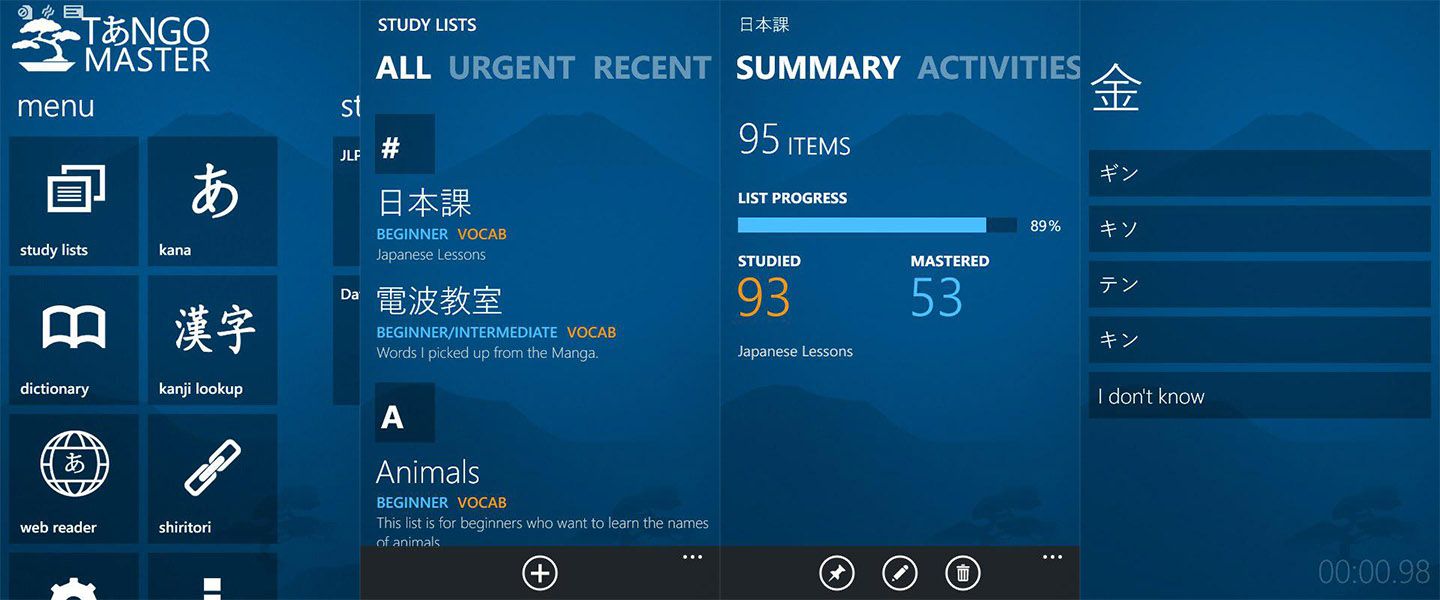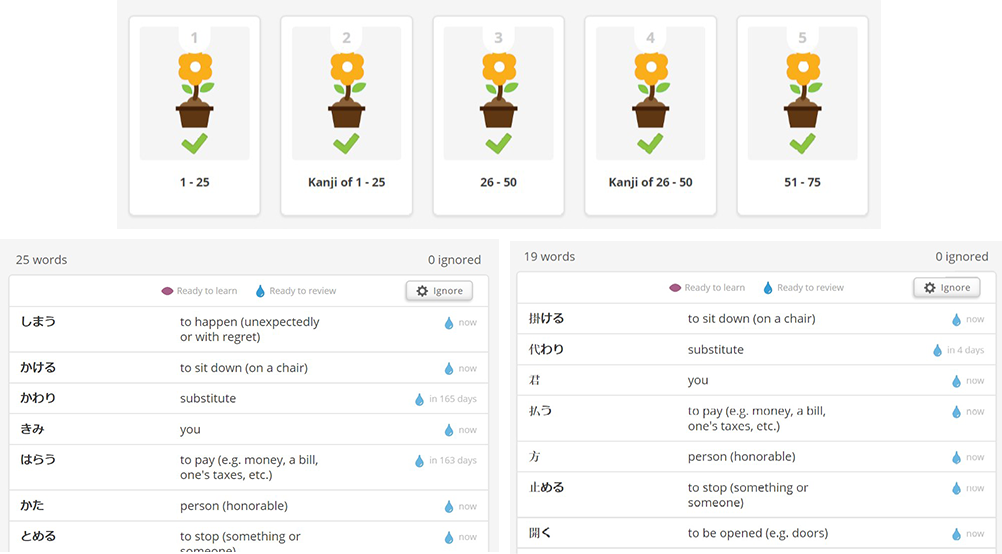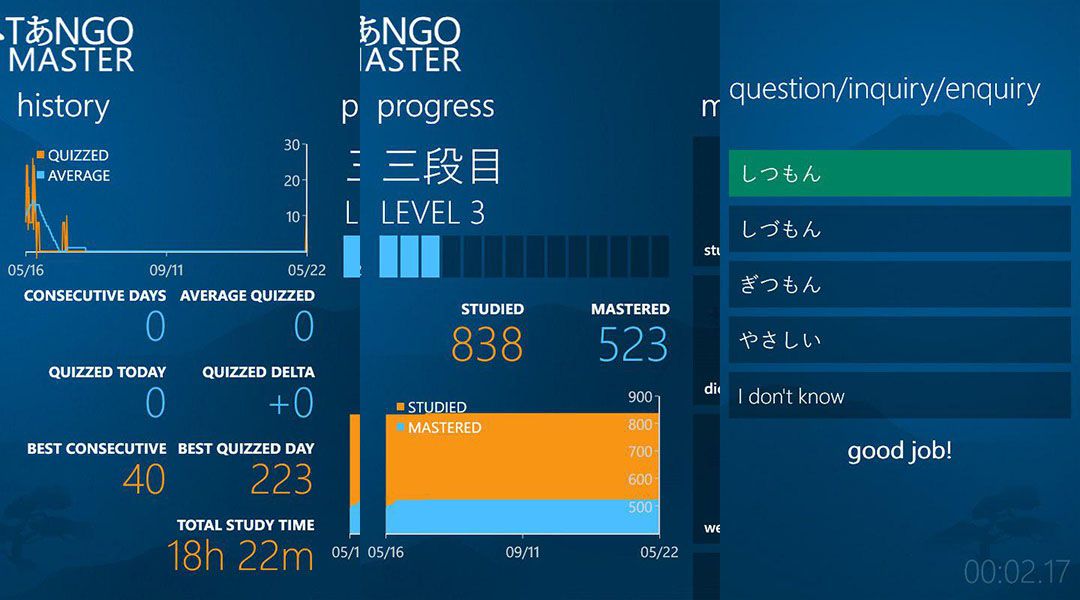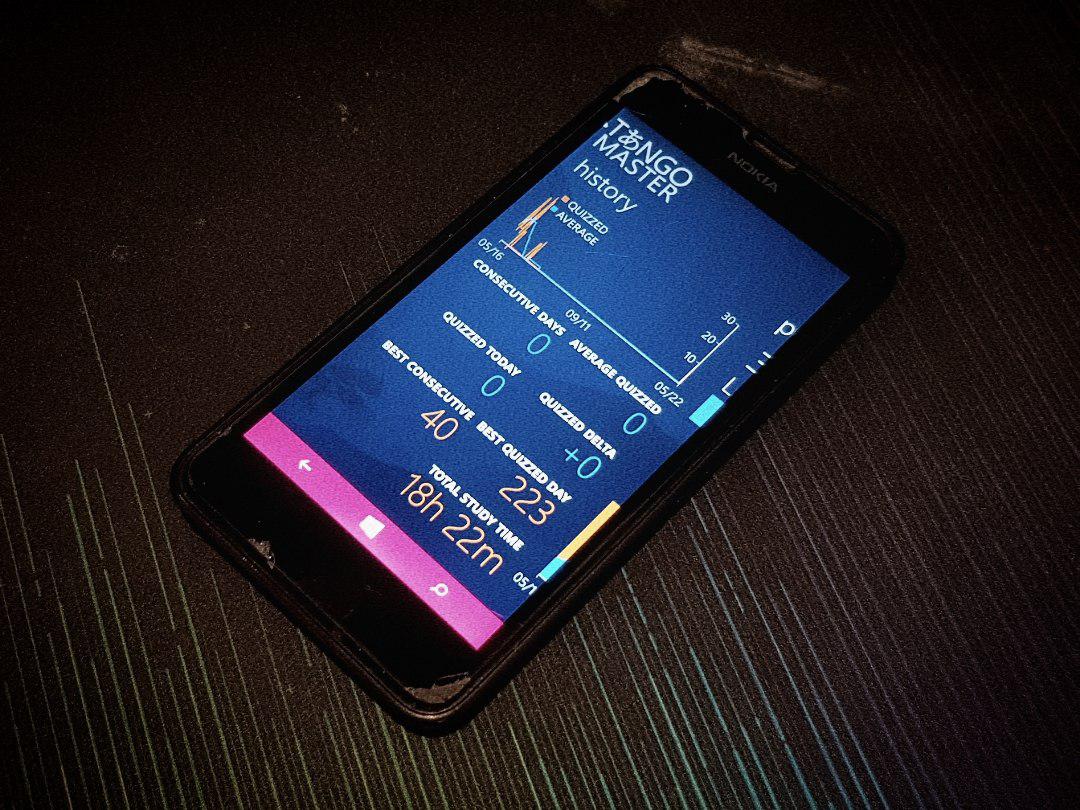With that out of the way, I have to say; Tango Master is the best flashcard app I have ever used and life without it has been a constant struggle. That last sentence may have been an exaggeration.
A bit of history
I started “studying” Japanese sometime back in 2010, when Windows Phones had just first hit the market. The upgrade from a Windows Mobile 6 to a Windows Phone 7 was quite a drastic one, but it did open up an app store allowing a much better app downloading experience.
One of the apps, Tango Master, was a simple Japanese flashcard app. I figured I may as well use that to learn some basic words to add to my abysmal vocabulary. Fast forward 18 months and I had added about 500 words to my vocabulary. Yes, I know that is not a lot, but I was not being very serious then.
In 2012, I switched out for an Android device but I still kept my Windows Phone device around solely for studying Japanese.
At some point, I completely lost interest and threw aside the phone along with my progress. Fast forward a few years and in the summer of 2017, I decided to seriously pick up Japanese again. This time I searched for a flashcard app on Android and came across Memrise.
After spending a few years on Memrise, I have come to realise there were many features that I had come to take for granted from Tango Master that was missing from Memrise. I tried downloading a few other flashcard apps as well, but none of them did it as well as I would have liked.
What is Tango Master?
Not to be confused with the 2012 Windows Phone Tango update or the dance of the same name, the word 単語 (tango) means ‘vocabulary’ in Japanese. That’s where the name came from.
Tango Master at its core was a spaced repetition flashcard app to help learners with memorising Japanese vocabulary. Besides the basic quiz functionality, it also provided a few other games and features for learning Japanese. It was seemingly developed by a sole developer and was completely free. It had plenty of mentions on various windows phone centric sites.

This was the final feature list before Windows Phone was killed off.
- Flashcards (kana, vocab, kanji)
- Quizzes
- Offline dictionary
- Kanji dictionary including stroke order and audio
- Web reader
- Mini games (Shiritori, Rapid Fire, Memory)
- Live tiles
- Romaji support
- Backup and Restore to SkyDrive
Why is it so awesome?
Personally, I think that Tango Master was a great Japanese flashcard app because of one main distinction, that it based it’s flashcards on a dictionary. I will get to why this is important soon, but first let’s talk about what a flashcard app is.
Deconstructing a flashcard app
At risk of insulting your intelligence, I will be explaining how a flashcard app works. Please bear with me.
A flashcard is a card with two sides used as a learning aid before these newfangled computers came about. One side would have the prompt, and the other has the answer. It could be used for anything from children how to read, to memorising advanced topics for an examination. A learner would look at the prompt, and think of the answer before flipping it over to reveal the answer and check if they got it right. Flashcards are primarily used for rote memorisation, which is arguably bad, but let's not get into that now.
Any flashcard app basically does just that, with a few added niceties. For starters, it would keep score of how many learners get right for a given set of cards. We could also throw in spaced repetition, a technique that is quite good at helping learners memorise things. This works by showing a learner the cards they get wrong more often. For the ones they get right, it will still come up every now and then to reinforce their memory.
For the most part, that’s what any of these flashcard apps do, and they work well to help learners memorise various things.
So what’s so special about Japanese?
This basic two sided flashcard method does not work well for Japanese. Each Japanese word or phrase one may want to learn usually consists of three parts, the reading, the kanji, and the translation. This means that in effect, a three sided flashcard for each word is required.
Here are a few examples:
| Reading / kana | Kanji | Translation / English |
|---|---|---|
| さいじょう (saijou) | 最上 | Best |
| べんきょう (benkyou) | 勉強 | Study |
| ほうほう (houhou) | 方法 | Method |
This means there are three possible combinations for testing someone.
- Reading ↔ Kanji
- Translation ↔ Kanji
- Reading ↔ Translation.
(If you take into account the romanisation of the reading, you could even argue you’d need a four sided flashcard.)
How regular apps handle this
Regular flashcard apps would simply get around this by simply having two or three sets of cards per word. For example, the JLPT N4 community course in Memrise would have a set for Reading ↔ Translation and another for Kanji ↔ Translation.

The problem with this is that the app does not have any clue as to how well you understand a word, which now comprises of two cards. It can only track how well you know a certain card.
For example. I may know that “あく” is “to open”, but if I were to be presented with the kanji “開く”, I may not know what that is. The app would simply record that the “開く ↔ to open” pair is something I didn’t know, when it should really be recording that I don’t know the kanji component of the word “開く ↔ あく ↔ to open”.
Why is this important?
When learning Japanese, it is important to understand both the kanji and the reading of a given word. In theory, if I wanted to, I should be able to learn all the reading ↔ translations of words. Then at some time in the future, I should be able to turn on the kanji, and it will start quizzing me on the reading ↔ kanji and translation ↔ kanji components of the words I already know.
In essence, the app would have a better understanding of my understanding of the words that I am learning.
How tango master handles this
Tango Master handles this in a simple way. When you are being tested on a word, it simply picks one of the three possible combinations and tests you on that. If you get it wrong, it records that you got that word wrong and it will test you on that word again in the near future. It can do this because the cards are based off a dictionary and it records your progress on the word and not on the card.
This, is in my opinion the one thing that sets Tango Master apart from all other Japanese learning flashcard apps.
Other cool things
Tango Master is a lot more than a simple flashcard app, it had a whole lot of other features as well like games and a web browser with a built in dictionary. For the most part, I only used the quizzing feature and this list of cool stuff mostly pertains to that feature.
Word progress carries across different study lists
Since the words are dictionary based, the progress will carry across different word lists. This is one thing that sort of irked me when using other apps, that I had to relearn words I already knew. Most apps have ignore or skip functionality, but it’s still nice that the app would already know which words in any given list you are familiar with.
The app is completely usable offline
This point was more targeted at Memrise. While taking the train, or being anywhere with spotty internet (which is basically everywhere with T-Mobile), I would be unable to do my daily Japanese learning. The app would seemingly need to connect to their servers before allowing me to use the offline mode that I paid for. That rant will be covered in a separate blog post.
Tango Master, not being a terrible company, does not have to keep checking their servers to verify that I’m still paying them.
It had nice stats
This is not to say other apps don’t have stats, but having a graph showing my progress really provided motivation to work on it every day. It may be just me that appreciates graphs, but any form of motivation is good. Also, it tells me I did a good job when I get it right. <3

Downsides to Tango Master
If the word you wanted to learn is not in the dictionary, there was no way of adding the word.
There were no phrases or sentences to learn, it was almost exclusively words.
There were no audio clips of native speakers reading the words. It did have a text to speech engine, but Memrise courses have audio of a native speaker reading the word or phrase. I think that is tremendously helpful.
There was no online functionality like leaderboards. Memrise provided leaderboards that were a great motivation for me to do my daily learning so I could beat my friends.
It was really only for Japanese, and couldn't be used for anything else.
Windows Phone, and hence the app, no longer exists.

If you wanted, you can still download Tango Master at third party hosting sites like this one. You’d have to buy a windows phone and side-load it though.
Tango Master is by no means an all in one Japanese learning tool. If you really want to learn Japanese (or any other language for that matter), you will need to expose yourself to a lot more of the language, and speak it as much as possible. It was a Japanese flashcard app that did a really good job at being a Japanese flashcard app, and didn’t try to be something else.
How Tango Master helped me study Japanese
First of all, learning a language is all about exposure and usage. Here is a video explaining that you need lots of input and context in order to learn a language.
With that said, I currently use Memrise (ugh) to learn new vocabulary, Takoboto for searching words and saving them, TangoRisto to read a daily short Japanese paragraph, JapanesePod101 to listen to Japanese learning podcasts, and iTalki to have private Japanese lessons at my own time.
At some point in the past, I was writing down Japanese song lyrics, learning how to sing it, and using that to bolster my vocabulary. It also had the added bonus of giving me something to sing during karaoke sessions.
I also bought some manga (in Japanese of course) with furigana and started translating the pages slowly and painfully. I would go at a pace of about one chapter a month and I think I managed to keep that up for 7 chapters. That endeavour has since been put on an indefinite hiatus.
The main reason I am lamenting on the loss of Tango Master is that I used to store words I encounter in manga, anime, songs, or even on the street in lists. I could then use Tango Master to quiz myself on the vocabulary and etch it into my memory.
I know that this is mostly an excuse and I could easily find another flashcard app to do just that. But it was very convenient to be able to add the words directly from a dictionary instead of having to input the Japanese and English when using a regular flashcard app.
I hope that one day, a good alternative will come up. In the meantime, I will simply stick to my current learning flow. Not that I have a choice anyway.